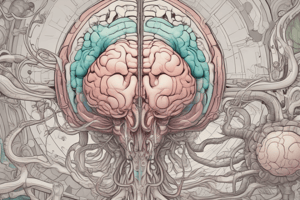Podcast
Questions and Answers
What is the primary function of the thalamus in the brain?
What is the primary function of the thalamus in the brain?
- To act as a relay station for sensory and motor information (correct)
- To process emotions and memory
- To regulate circadian rhythm
- To coordinate movement and spatial skills
Which structure connects the lateral and third ventricles to the fourth ventricle?
Which structure connects the lateral and third ventricles to the fourth ventricle?
- Choroid plexus
- Fourth aperature
- Cerebral aqueduct (correct)
- Subarachnoid space
Which area of the brain is primarily responsible for language comprehension?
Which area of the brain is primarily responsible for language comprehension?
- Wernicke's area (correct)
- Cerebellum
- Broca's area
- Thalamus
What is the result of damage to Broca's area?
What is the result of damage to Broca's area?
Which hormone is secreted by the pineal gland?
Which hormone is secreted by the pineal gland?
Which lobe of the brain is responsible for judgment and problem-solving?
Which lobe of the brain is responsible for judgment and problem-solving?
What are the reflex functions of the superior and inferior colliculi?
What are the reflex functions of the superior and inferior colliculi?
How does the cerebellum contribute to muscle movement?
How does the cerebellum contribute to muscle movement?
Flashcards are hidden until you start studying
Study Notes
Ventricles of the Brain
- Lateral ventricle x2: one in each hemisphere
- Fourth ventricle: connects to the central canal of the spinal cord
- Third ventricle: located in the diencephalon, connects to the lateral ventricles via the cerebral aqueduct
- Choroid plexus: a network of capillaries and ependymal cells that filter blood to produce cerebrospinal fluid (CSF)
- CSF flows from the ventricles to the subarachnoid space through apertures (openings)
- Subarachnoid space: the space between the arachnoid mater and pia mater, surrounds the brain and spinal cord
Brain Lobes
- Frontal lobe: responsible for judgement, problem-solving, understanding sequences, emotions, memory, and learning
- Temporal lobe: responsible for sense of hearing, smell, memory, and language
- Parietal lobe: involved in processing sensory information, spatial awareness, and navigation
- Occipital lobe: responsible for vision
Brainstem Divisions
- Midbrain: the superior part of the brainstem
- Pons: the middle part of the brainstem
- Medulla oblongata: the inferior part of the brainstem
Thalamus
- Relay station: processes and relays sensory and motor information to the cortex
- All sensory information, except smell, passes through the thalamus before reaching the cerebral cortex
Epithalamus
- The main structure is the pineal glad which is an endocrine gland
- Melatonin: a hormone produced by the pineal gland and involved in the regulation of circadian rhythms
Midbrain Reflexes
- Superior colliculi: responsible for visual reflexes
- Inferior colliculi: responsible for auditory reflexes
Cerebellum
- Located in the posterior/inferior portion of the brain
- Functions: coordination of movement, spatial skills, and puzzle solving
- The cerebellum receives signals from the frontal lobe before they are sent to the skeletal muscles
Language Areas
- Wernicke's area: located in the left temporal lobe, responsible for language comprehension
- Broca's area: located in the left frontal lobe, responsible for language production
- Damage to Wernicke's area: "word salad" speech that doesn't make sense
- Damage to Broca's area: difficulty producing speech, "broken speech"
Studying That Suits You
Use AI to generate personalized quizzes and flashcards to suit your learning preferences.



